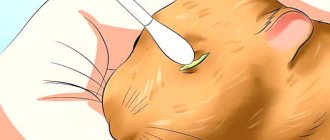Pets can also get sick, including various skin diseases. More often, hamsters experience baldness for various reasons, allergic dermatitis and, less commonly, lichen.
Ringworm in a hamster manifests itself in the form of bald areas of skin, itching and scabs from scratching.
To make an accurate diagnosis, it is important to contact a veterinary clinic, because the disease is infectious in nature and does not go away on its own.
The specialist will determine whether this disease can be dangerous for humans and will suggest how to treat the animal by selecting the appropriate medications.
Domestic rodents are susceptible to several types of fungal skin infections:
- scab;
- dermatophytosis;
- ringworm.
They all have similar symptoms and are infectious in nature, and the last two are contagious to humans.
The main symptoms of a hamster disease
The pet cannot complain about deterioration in health. His appearance and changes in behavior will tell you about health problems. A healthy pet is active, has a smooth coat and bright eyes. If the hamster’s mood has changed, he has become passive, his fur has lost its shine, wet spots have appeared on his face or in the tail area, then he needs help. Symptoms of hamster diseases that should alert the owner are as follows:
- change in pet behavior;
- refusal to eat;
- diarrhea and wet hair around the tail;
- frequent urination;
- lacrimation;
- scratching of the skin and hair loss;
- sneezing and breathing problems.
Now let’s tell you a little about what diseases in hamsters cause such symptoms.
Why does shedding occur?
All animals sooner or later begin to change their fur. Hamsters are no exception. This can occur for several reasons.
- Due to age. The bottom line is that at the age of 5 months, hamsters can change their fluffy fur to denser hair (molting is observed).
- Due to seasonal processes. Hamsters shed only in spring and autumn. This is due to the fact that weather conditions are changing.
Article on the topic: Why does a hamster sleep constantly: normal or abnormal?
Usually the molting process cannot be seen with the naked eye. If your rodent is not sick and is quite active, then there is no need to worry. This is a normal physical process that cannot be influenced. For example, small Djungarian hamsters have only three coat colors. As soon as they “survive” the moult, the number of shades doubles.
Hamster's wet tail
A dangerous disease called proliferative ileitis among hamster owners is called “wet tail”. In fact, it is the wet spots around the tail caused by diarrhea that are its most striking symptom. The disease is also characterized by foul-smelling discharge, often bloody. In advanced cases, your pet may experience intestinal prolapse.
This is a contagious infectious disease. If the animals are kept in a group, you must immediately remove the sick pet and thoroughly disinfect the house.
A sick pet should be taken to the veterinarian as soon as possible. The doctor will select antibiotics and calculate their dose taking into account the pet’s light weight. The veterinarian will also prescribe injections to replenish fluid loss (due to diarrhea, the animal is at risk of dehydration). To feed a hamster, solutions are used to restore the water-salt balance. Traditional methods include a decoction of oats or rice; it will not replace treatment, but will help the animal wait for a visit to the veterinarian. It is necessary to adjust the menu, exclude fresh fruits, vegetables, and herbs. Unless otherwise recommended by your veterinarian, the main food for the duration of treatment is hay.
Among all the diseases of hamsters, wet tail is one of the most dangerous. Without the help of a veterinarian, the pet will die.
Scab
This is a viral disease characterized by the appearance of a white coating on the affected areas. A scaly plaque forms on the ears, tip of the nose, and eyebrows, which over time becomes covered with gray blisters. They have a round shape, the diameter is constantly increasing. After some time, a crust with remnants of animal hair appears on the wounds. Scab is especially active during the warm period - spring and summer. The incubation period lasts about two weeks. A hamster can become infected with this disease through contact with sick animals, from insect bites, through contaminated cage litter and food.
Treatment of the animal should begin with cleansing the affected areas. To do this, the scabs must be softened with oils or fats. Then the foci of infection are treated with an alcohol solution with the addition of salicylic acid and iodine. The procedure must be repeated several times a day until the animal is completely cured.
During treatment, it is necessary to isolate the hamster from other animals, as this disease is very contagious. The rodent's cage, toys and bowls must be disinfected with special means. Once you have isolated the animal, change the bedding to pine sawdust and thoroughly clean the floors. The room where the animal's house is located must be well ventilated.
Eye diseases in hamsters
If your hamster has discharge from his eyes, they turn red, and his eyelids begin to stick together, there is a high chance that he is dealing with conjunctivitis. Allergic conjunctivitis can be caused by detergents used to treat the cell, as well as new products, especially exotic ones. It is important to eliminate the causes of allergies; over time, the situation will normalize.
Eye disease can also be caused by infection and injury. Microorganisms multiply in the litter, and the hamster actively scatters it with his nose, dust and debris fly into his eyes. If you do not change the filler in the cage in time, the hamster may get sick from multiplying bacteria.
Eye injuries in rodents are common. The smallest particle of sawdust that gets under the eyelid is enough to scratch the cornea.
If you suspect eye disease in hamsters, you must carefully examine the animal. The eyes are carefully washed with saline solution or a special lotion. Use a separate cotton pad for each eye. The examination will help determine whether your pet needs a visit to the veterinarian. The doctor may prescribe special drops, depending on the cause of the disease.
But with any diagnosis, cleaning the cage is mandatory. It is better to remove the bedding completely during treatment, covering the bottom of the cage with clean paper.
Prevention
The disease is easier to prevent than to treat. With regard to skin diseases in rodents, the following measures must first be observed:
- do not approach the hamster in street clothes and shoes;
- handle your pet with washed hands;
- follow quarantine rules after acquiring a new animal;
- maintain the animal’s home in good sanitary condition;
- protect your pet from stressful situations.
If trouble happens and the pet dies from skin problems, then before purchasing a new hamster you need to do a general cleaning of the room and thoroughly disinfect all equipment and the cage.
The health of pets depends on the owner. Inattention and negligence can destroy even such an unpretentious creature as a hamster.
Hair loss and other diseases of hamsters
Hamsters are also susceptible to fungal and parasitic diseases. Most often they affect the pet's fur. Baldness, wounds from scratching, weeping spots on the skin, crusts are signs of a hamster illness.
When examining a sick hamster, be sure to wear gloves and follow safety precautions. Some diseases, such as shingles, can be transmitted from pets to humans. Treatment is carried out with antifungal drugs. If your pet scratches the skin so that the wounds become infected, the doctor will recommend external antibacterial ointments.
Scabies caused by mites is treated with antiparasitic medications. It is important to thoroughly disinfect the cage.
When fed only prepared diets, without adding greens, hamsters develop vitamin deficiency. It manifests itself in partial baldness. After adding green food to the menu, the pet’s condition returns to normal.
Parasites such as lice and lice eaters are rare in hamsters. Sometimes other pets (cat or dog) can “reward” the hamster with fleas. In this case, it is necessary to treat all pets. Unless otherwise advised by your veterinarian, drops or kitten spray are used for hamsters. It is necessary to recalculate the dosage taking into account the weight of the pet. The drops are applied to a cotton swab and then wiped over the pet’s withers. After 2 weeks, the treatment is repeated. Disinfection of the cage is mandatory.
But the dark spots on the sides of the animal are not a disease, but the consequences of excessive pigmentation.
Reasons for constant scratching
Needless to say, few people like it when someone constantly bites them. And domestic rodents are no exception. We’ll talk about what can cause severe itching and a situation where hamsters’ hair falls out right now.
Scabies
Scabies can be a possible reason why your hamster is going bald. Scabies is caused by microscopic mites that live in the upper layers of the epidermis or hair follicles. Ticks that parasitize hamsters are conventionally divided into skin beetles, skin beetles and itches. The former feed on keratinized skin and dandruff; the epidermis live directly on the surface of the skin, sucking blood and lymph. Itches live in the upper layer of the skin, make their moves there and feed on the subcutaneous tissue.
What to do if your hamster gets sick
A sick pet must be removed from other rodents. Consultation with a veterinarian is required - only a specialist can establish a diagnosis and select medications.
During treatment, it is important to ensure that the hamster does not become hypothermic. His body is weakened, and the slightest draft can be disastrous. If the house is cool, it would be a good idea to put a heating pad in the cage. Be sure to keep the area clean by frequently changing the bedding. It is important that your pet has access to clean water.
Stress weakens your pet, so try to create the most comfortable conditions for him. Don't make noise near the cage, don't pick him up more often than necessary.
Ticks
Ectoparasites on a hamster are quite common, but they do not bother the animal, since their number is usually small.
For a clear clinical picture of the disease to appear, they must be accompanied by vitamin deficiencies, weakened immunity, or poor hygienic conditions.
Causes and symptoms. Rodents are most often affected by Demodex mites, which are the causative agents of demodicosis.
With this disease, the pet experiences itching, dandruff, increased hair loss, dry and irritated skin.
Hamsters are often parasitized by Notoedres mites, the causative agents of notoedrosis.
This pathology is characterized by severe itching, hair loss, and the formation of dry crusts and dandruff on the face, ears, cheeks and limbs.
To get rid of itching, animals itch, the skin is damaged, and this leads to infection.
Rodents become irritable, refuse food - the result is exhaustion, which can be fatal.
Another type of scabies is caused by the scabies mite Sarcoptes anacanthos. With sarcoptic mange, pets itch severely, damaging the skin and infecting the wounds.
Pustules form throughout the body, which turn into scabs and scabs.
Without timely and effective help, a small pet may die 3-4 weeks after the first symptoms appear.
To get rid of ticks, use local preparations in the form of powders, sprays, ointments, shampoos with selenium sulfide or oral insecticides. Diagnosis and treatment should be carried out by a veterinarian.
The drugs metrifonate and cythioate showed good results. For sarcoptic mange, infected animals are bathed in a 0.5% bromocyclene solution.
To cure a hamster from notoerdrosis, the affected areas should be treated with a 3% solution of the drug SK-9, sulfur ointment, the course of recovery is 7-10 days.
In case of bream, the pet must be isolated from other individuals, and the cage and objects with which it has been in contact must be disinfected. This will prevent re-infection.
What drugs are prohibited for treatment?
Human medications are not always suitable for rodents. For example, penicillin antibiotics are absolutely not suitable for them. Cephalosporins are also prohibited. Traditional medicine can also be dangerous for your pet.
Now you know about hamster diseases, how to treat them and how to help your pet. But it is important to remember about prevention. Spend time with your pet often to notice the first signs of behavior change. With proper care for your hamster, the risk of disease is low. Monitor your pet's diet, regularly clean and disinfect its cage - and your hamster will delight you with excellent health.
How can I help my fluffy?
The main thing is to pay attention to the itching animal in time. Of course, it will not be possible to diagnose the disease on your own. The first thing you need to do is isolate the itching hamster. The veterinary clinic must take skin scrapings from your pet, possibly fragments of fur, and use them to determine the presence of a particular parasite. If there are no parasites, the hamster may be suspected of having an allergy.
A veterinarian must prescribe drug treatment for a hamster, because due to its miniature size, the animal needs minimal doses of medication, which is not always possible to calculate independently. Stronghold drops are excellent for killing ticks. To get rid of fungus, bathing in special shampoos and treatment with antifungal ointments are suitable. It is imperative to disinfect the cage to destroy tick and flea eggs or fungal spores.











